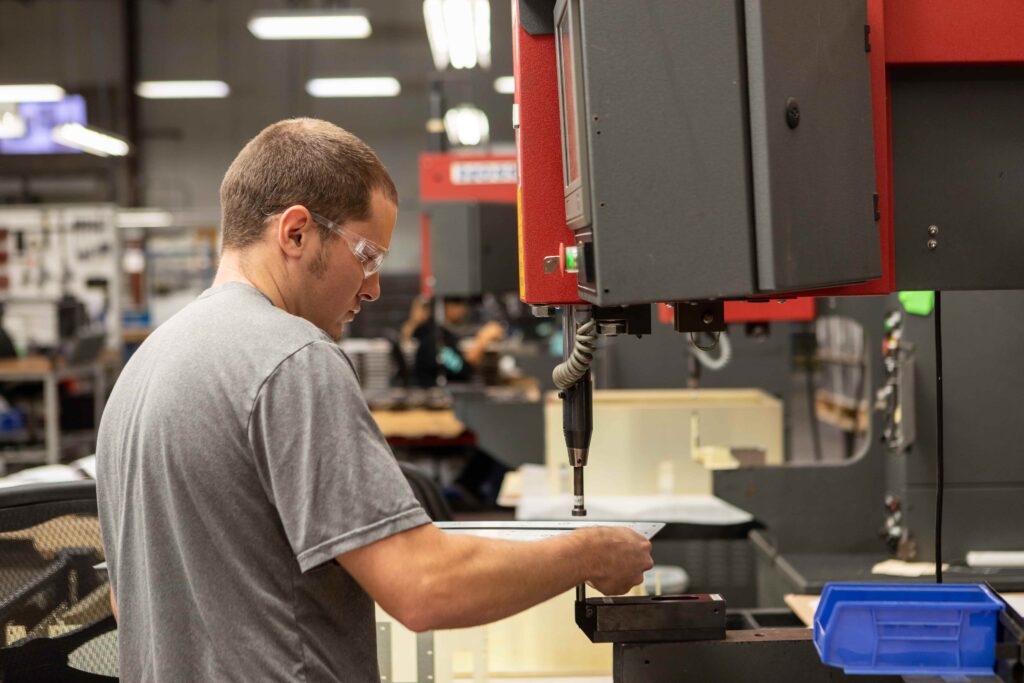Integrating Aerospace Hardware into Sheet Metal
The age-old idiom, “The devil is in the details,” stresses the importance of thorough completion of any job. In sheet metal production, those details of such important significance are in sheet metal hardware installation. The sheet metal hardware selected for any job is important because it can greatly impact the overall form, function, and appeal of a product. By understanding the challenges of sheet metal hardware installation and some options to overcome those challenges, sheet metal fabricators are able to finish any custom job with details that even the devil cannot deny.
Hardware Installation Challenges for Sheet Metal
The details of sheet metal hardware can be overwhelming to manage given the high number of challenges associated with sheet metal hardware installation. The challenges for sheet metal hardware installation fall into two general domains: installation and quality. The specific issues with hardware installation for a particular sheet metal project will depend upon the specifics of that job.
Sheet metal hardware installation can be tricky to develop an installation protocol. In sheet metal product fabrication, hardware installation can be an expensive endeavor because it is often one of the final stages of production. The product is close to being finalized when sheet metal hardware is implemented—the risk is great because there is already a great deal of investment in the item. Sheet metal hardware installation can also be an arduous process because it oftentimes involves multiple steps to complete the installation. Each time through the sheet metal hardware installation process is a risk that a mostly completed sheet metal product can be ruined. Professionals understand this challenge for sheet metal hardware and will likely select sheet metal hardware that is most appropriate for a particular project.
Common Issues with Hardware Finishes
Sheet metal hardware installation also presents challenges in the finish of the hardware. Specifically, sheet metal fabricators struggle with two recurring issues. First, sheet metal hardware can be difficult to install without mistakenly damaging the sheet metal hardware during installation (e.g., missing fasteners or misaligned holes). Professionals are aware of this issue and strive to overcome any challenges with sheet metal hardware. Second, sheet metal hardware installation relies on consistency. Sheet metal fabrication can be a game of millimeters or fractions of an inch. In order for sheet metal products to function and sustain, the hardware that holds them together must be installed exactly right. The devil is truly in these details as sheet metal hardware installers must be precise and consistent.
The challenges to sheet metal hardware installation are great. Flawed hardware installation can cost a lot of time, energy, and money. Sheet metal operators have developed multiple strategies for overcoming these struggles. The most tangible of these is to implement a style of hardware for sheet metal that is most appropriate for the project at hand. Specifically, two types of sheet metal hardware seem to be successful at minimizing these challenges: PEM-style sheet metal hardware and aerospace-style sheet metal hardware.
PEM Style Hardware for Sheet Metal
PEM hardware is an ideal sheet metal hardware for projects made with thin, hard surfaces such as automotive manufacturing. This light sheet metal hardware can be flush with the product so there are no noticeable seams. Hardware can be installed in a single-step permanent press directly into the sheet metal. Sheet metal can be finished before installation, as there are no extra steps required such as embossing or welding.
How to Install PEM Style Hardware in Sheet Metal
During the installation process of PEM hardware, sheet metal is pressed through holes to tightly hold the hardware pieces together. PEM-style hardware does not require heat (e.g., welding) to maintain the tight hold so there is little risk of destroying a nearly finished sheet metal product during sheet metal hardware installation. PEM-style hardware can be held in place through self-clinching, without requiring additional loose hardware.
As the force of the pressure to insert the hardware into each other is exerted, that pressure also seals the items together through sheet metal hardware (e.g., teeth, serrated clinching ring) so that the sheet metal will stay connected. PEM-style hardware developers have moved away from threaded-style sheet metal hardware because the threads increase the demand for precision and room for error during sheet metal production. And threads in sheet metal hardware can become stripped and lose their grip. These new bonding technologies are more consistent and durable. And made PEM-style hardware installation a smoother process.
Aerospace-Style Hardware for Sheet Metal
Aerospace-style hardware is a specific style of sheet metal hardware ideal for sheet metal fabrication because of its high strength-to-weight ratio. The hardware is also a perfect finish for custom sheet metal fabrication because of the additional demands that this detailed sheet metal hardware can fulfill. Aerospace-style hardware is designed to work in extreme environments, high pressures, and for long periods. The reliability and durability of this sheet metal hardware provide a strong finish with attention to the details of any job.
How to Install Aerospace-Style Hardware in Sheet Metal
Aerospace-style hardware is installed in traditional ways with high-tech modifications. Generally, aerospace-style hardware relies on threaded bits and joints. While traditional in conception, this style of sheet metal hardware is installed in innovative and advanced ways. For example, sheet metal hardware is often made of composite materials. This makes it capable of withstanding a number of potential environments. The tools used for this style of hardware installation (e.g., automated drilling systems or the Flex Track handheld drill) make the precision and consistency necessary for this sheet metal hardware installation a simple task.
Sheet metal hardware installation can be a difficult process with many challenges. With professional guidance and careful consideration of the particulars of a sheet metal project, sheet metal hardware can be a smooth finish to any sheet metal product.


